Should You Buy a Shipping Container Pool? We Think YES!
As environmental awareness increases, we continue to see a huge shift towards environmentally friendly alternatives to everyday items in today’s society. Not only are these alternatives promoting the safekeeping of the limited or finite supply of resources we have on Earth, but they are also highlighting the creative ways we can manipulate things for different uses.
Looking to buy or rent a shipping container? Get an instant quote now >
Remodeled shipping containers are just one of the many environmentally friendly alternative structures seeing a rise in popularity. Shipping containers are consistently being transformed into different structures, such as drive-thru restaurants, sheds, and storage units, but there’s also another form on the rise– shipping container pools.
We know the concept of a shipping container pool may sound a little out there, but it’s actually a great way to reduce, reuse, and recycle while taking a quick dip. Still have questions? Not to worry. In this article, we’ll give you all the information (and then some) about shipping container pools, from installation and popular features to some ideas for how you can develop your own at home.
How Do You Install a Shipping Container Pool?

It’s important to understand the process of installing a shipping container pool before purchasing one. Image courtesy of Dwell.
Installing a shipping container pool is a great idea. But you’ll need to know the right process for installing one so you don’t accidentally demolish your backyard or purchase a shipping container with a hidden leak. Let’s explore the correct way to install so you can reap the benefits of your shipping container pool without issue.
Permits
For starters, you’ll need to consider any permits you might need from your local municipality zoning office before installing a shipping container pool. There are a variety of permits that you’ll likely need– including ones for plumbing, electrical work, and the actual construction of your pool. There are usually permits required for both aboveground and in-ground pools.
Secure any permits you might need, and pay any applicable fees, before moving forward. A little bit of research should be able to tell you what kind of shipping container pool you can install on your property, but if you have underlying questions, call your association or local housing authority for more information.
Sizes
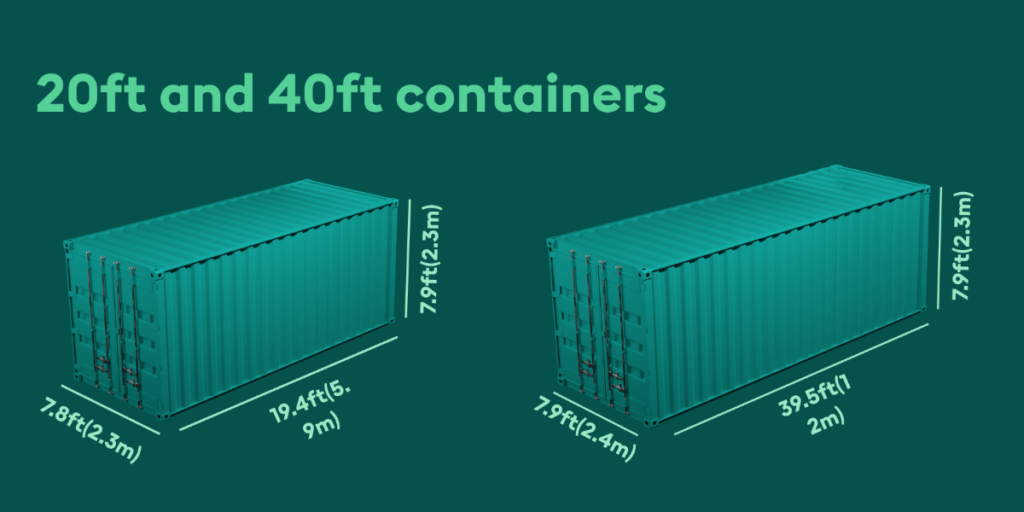
Pick what size you want your shipping container pool to be. Image courtesy of Container-Xchange.
Next, consider the size of the pool you want to build. Shipping containers typically come in either 20′ or 40′ sizes, so those are two easy options to pick from. Shipping containers are usually 8 ft 6 in tall, while certain high cube shipping containers provide an extra foot of height.
Either way, you’ll need to cut or modify your container to get to your pool’s desired depth. But the key thing to decide is how deep and how wide you want your pool to be ahead of time, so you don’t purchase a container that doesn’t fit the space you have provided on your property.
Foundation and Reinforcement
Now it’s time to construct the foundation for your pool. Purchase the supplies for and lay a concrete slab foundation where the bottom of your pool will sit– whether that’s above-ground or in-ground. The foundation will support the container and the eventual water’s weight. Do not skip this part– otherwise, your container may leak and break after some time.
After you secure your shipping container, you’ll also need to reinforce the walls and base of the shipping container so it can contain all the water for your pool over the long-term. Shipping containers are not designed to store water inside by default, so you’ll have to reinforce the walls with steel and other materials.
Pool Linings
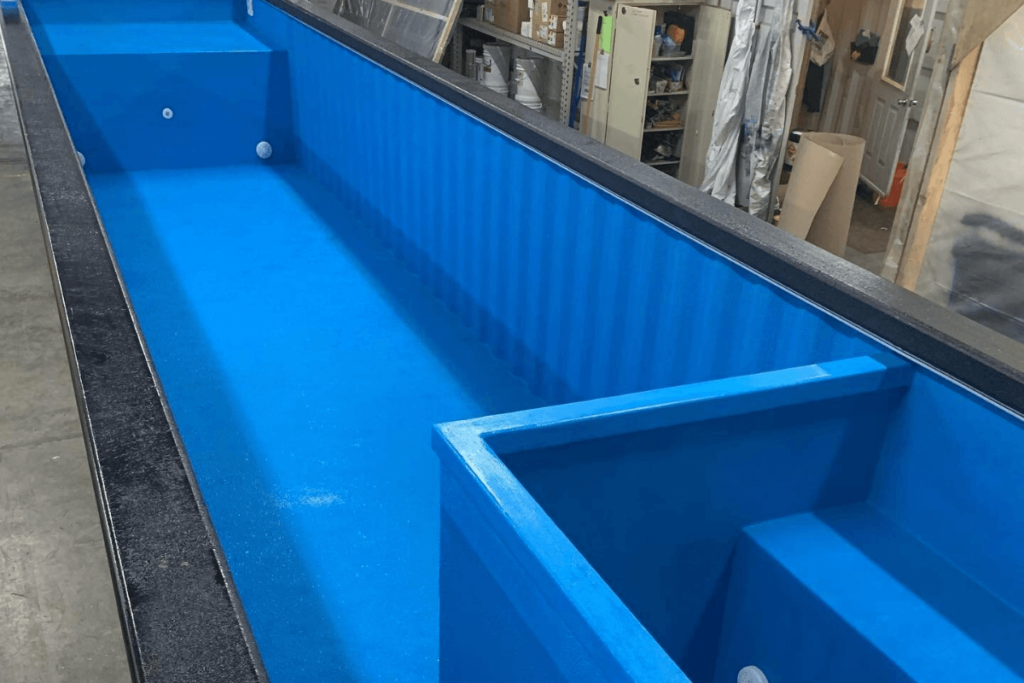
You’ll also want to add a pool lining to polish out your shipping container pool and keep it watertight. Image courtesy of Intermodal Containers For Sale.
In addition to reinforcing your shipping container with steel and other external supports, you’ll also want to pay close attention to the inside of your pool. Consider using a waterproofing method to make sure there won’t be any leaks to contend with in the future. Secure any steel sheets on the walls with watertight welding processes and materials.
It’s also a good idea to prevent water spillage by welding a flat plate over your shipping container’s lip. The lip can also be bolstered by timber cladding, which makes for a smoother surface.
It’s also wise to be selective about what kind of liner to use on your pool. Pool liners vary greatly in price, and can be made of various materials, including epoxy, plastic polymer, vinyl, and fiberglass. This will take your pool from a simple metal shipping container to a luxurious spot to take a dip!
Only after fully preparing your shipping container, ensuring that the site on which it is to be located is level, and reinforcing the container’s walls for water storage can you actually install it. Be sure to hire experienced engineers and contractors to do the installation for you, since they’ll be able to make sure that your water pipes are hooked up properly and your filtration system is working on the first try.
What Are the Shipping Container Pool Features?
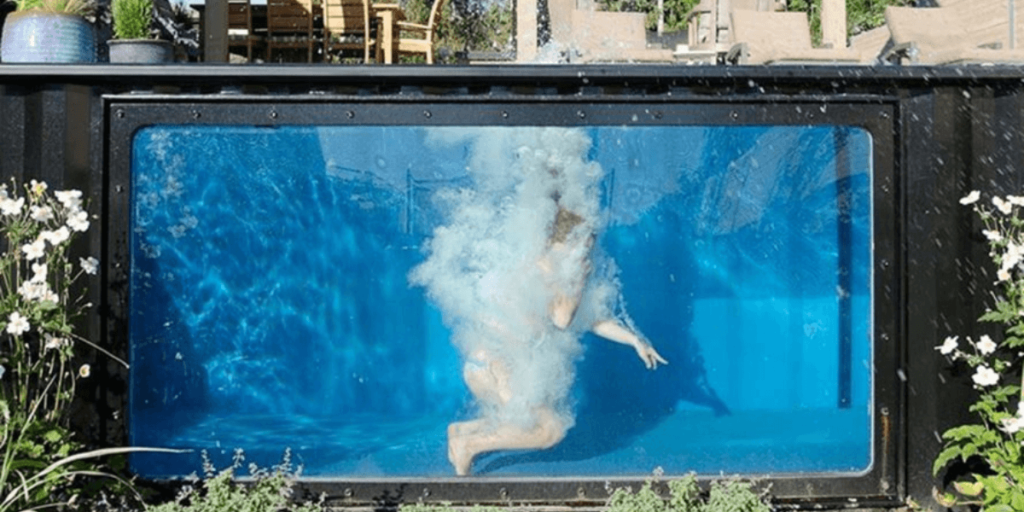
Shipping container pools can come with a variety of special features, including glass sides, dividers, heaters and hot tubs, and underwater lighting. Image courtesy of Inhabitat.
Just like conventional pools, shipping container pools offer a variety of features. If you are looking for a hot tub or a combination of a pool and hot tub, you can consider adding heating and divider features to a shipping container pool.
If you are wanting a pool for training purposes, elongated shipping containers are great for swimming laps. However, if you want to have a training section for the pool as well as a place for the kids to play simultaneously, dividers can again be useful to add multiple sections.
You can also apply additional features to help spruce up your shipping container pools like color changing LED lights. In this day and age, you can conveniently control both the heating and light features from the click of a button on your smart devices.
Other shipping container pool features often available include adding doors, ladders, glass, etc. to personalize it and make it feel less industrial. However, for some people, the industrial look goes well with their aesthetic, and they enjoy keeping their shipping container as is for their pool. It really depends on you and what you are looking for.
Above Ground vs. In-Ground Shipping Container Pools
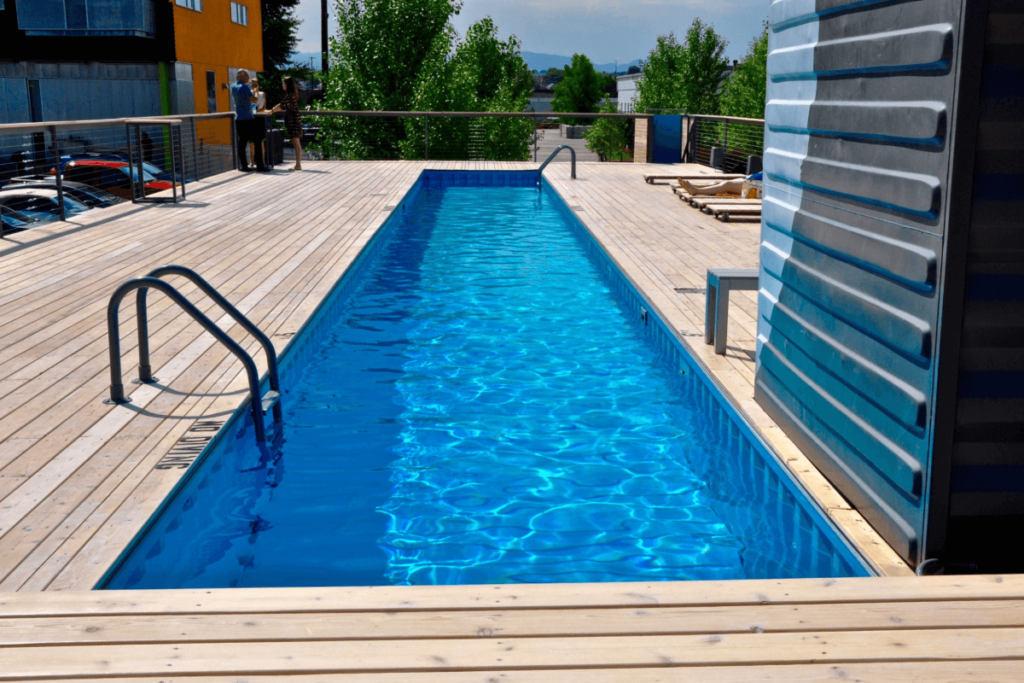
Shipping container pools, like traditional pools, can either be installed aboveground or in-ground. Image courtesy of Shipped.com.
One of the biggest differences that we see with aboveground and in-ground shipping container pool options, apart from the installation process itself, is the entry and exit points. For in-ground shipping container pools, you are able to get in and out of the pool just like a traditional in-ground pool. You can enter and exit the pool from anywhere around the pool and have dozens of entry and exit points.
However, for aboveground shipping container pools, you will likely have a single entry and exit point via a ladder or a similar method. Again, due to installation services and fees, the in-ground shipping container pool options tend to be more expensive than the above ground shipping container pool option. The layout of your specific property– including whether or not you have a deck or your neighborhood’s construction restrictions– will also likely have an effect on whether an aboveground or in-ground pool is best for you.
What is the Cost of a Shipping Container Pool?

Shipping container pools cost less, on average, than traditional pools. Image courtesy of iContainerHome.com.
The price of shipping container pools can differ depending on a lot of different factors, the main one being the size of the shipping container. When comparing traditional in-ground pools to shipping container pools, though, we see a huge difference in price.
Traditional in-ground pools, for example, typically cost anywhere between $41,750 and $80,000, with modifications often bringing the price up to as much as $125,000. The average price, as of 2024, is around $60,350. On the other hand, shipping container pools usually cost somewhere between $16,500 and $39,900. Like other shipping container structures, shipping container pools are an incredibly cost effective option. The range of cost for shipping container pools generally falls below the average cost of any traditional or conventional in-ground pool option.
Another cost to keep in mind that may not apply to everyone is the cost of moving. If there ever comes a day where you and your family decide to move, you could move your shipping container pool with you. This makes the investment of a shipping container pool even more appealing. You can either leave the shipping container pool in the house that you are selling and increase the value of your home, or you can simply take the shipping container pool with you. If you decide to take the shipping container pool with you, the logistics will obviously have an additional cost associated with it. This again differs depending on the size of your shipping container pool.
Can You Move a Shipping Container Pool?
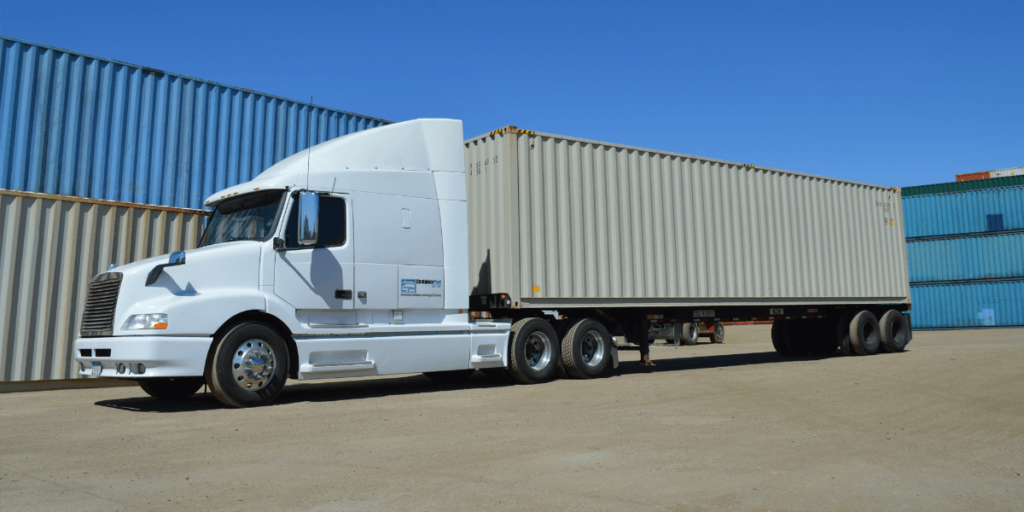
Shipping container pools can be moved relatively easily. Image courtesy of World Group.
So can you really move a shipping container pool to your new home? The quick and easy answer is yes! The nature of a shipping container is that it is used for shipping and moving things from one location to another, so you can certainly move your shipping container pool to another location if you decide to move or want to place it at another location.
There are different methods you can use to move it from one spot to another, depending on various factors, including the size of the pool. For a larger shipping container pool, a crane can be used to move it in a matter of minutes. The process overall is relatively quick and easy, though we wouldn’t suggest doing this kind of thing on a regular basis.
Do Shipping Container Pools Rust?
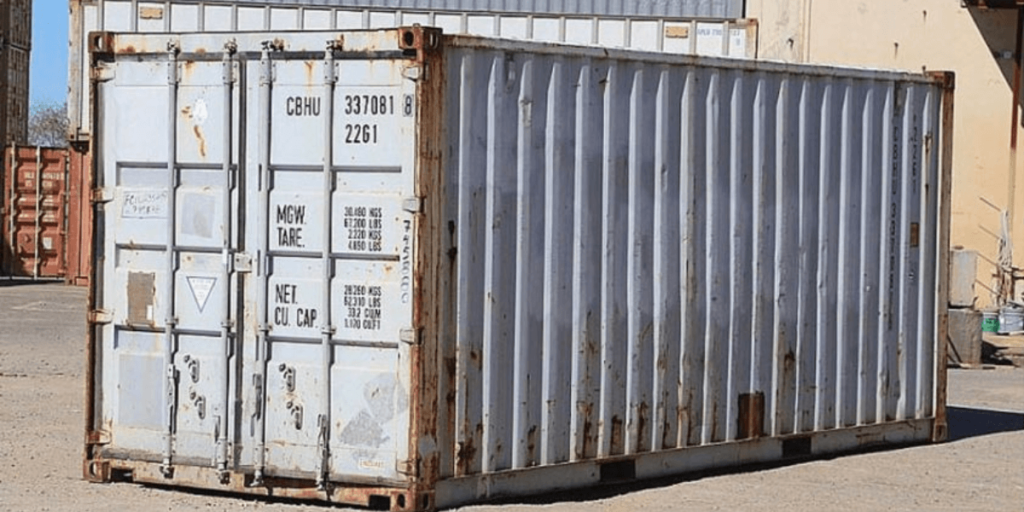
A properly-lined shipping container pool will not rust easily and will last longer. Image courtesy of Mobile Modular.
We understand that wear and tear is a valid concern. Since shipping container pools are made of metal, and we know metal rusts, there is a chance that the shipping container pools can rust over time if nothing is done to protect them or prevent that from happening.
With that said, we have come up with a few different ways to help prevent shipping container pools from rusting. For example, you can line the shipping containers with a layer of fiberglass or apply a coat of zinc paint to slow the natural rusting process down.
Shipping containers are incredibly durable, and outside of a pool setting, they are meant to last decades, typically between 15 and 30 years. We just have to use more creativity and science to prevent or deter the process of rusting. Check out our best practices to make your shipping container last as long as possible to ensure you do what’s necessary to prevent any damage.
Shipping Container Pool Ideas
Similar to the fact that shipping container pools in and of themselves are incredibly creative and innovative, there are plenty of things that you can do to make your shipping container pools more creative and stand out to all of your friends and family!
If you have kids and the shipping container pool is above ground, you can decorate the outside of the pool to blend with the theme of your backyard or home. As mentioned before, whether you decide to go with the above ground or in-ground shipping container pool option, you can make one pool into many by adding and/or dividing multiple shipping containers. Are you someone who enjoys swimming for exercise, but has kids who love to splash around? This is a great opportunity to easily divide a shipping container pool into both a place to train and have fun in your backyard.
Looking to take your pool aesthetic to the next level? Transform the walls of the shipping containers with glass for a chic, futuristic look incorporated with the industrial aspect of the shipping containers.
Bottom line, there are hundreds of ways to get creative with the placement and features of these shipping container pools.
Start Your Shipping Container Pool Journey with Rent-A-Container
Shipping container pools are a great option for everyone– bachelors, families and children– and provide many benefits traditional pools can’t. And the first step to developing your shipping container pool is finding quality, affordable containers!
Rent-A-Container sells and rents a wide selection of shipping containers. Although we aren’t your one-stop shop for shipping container pools, many of our containers can be modified, lined, and installed as pools– either by you or by skilled engineers. If you’re in the market for a shipping container pool, be sure to browse our selection of available containers.


